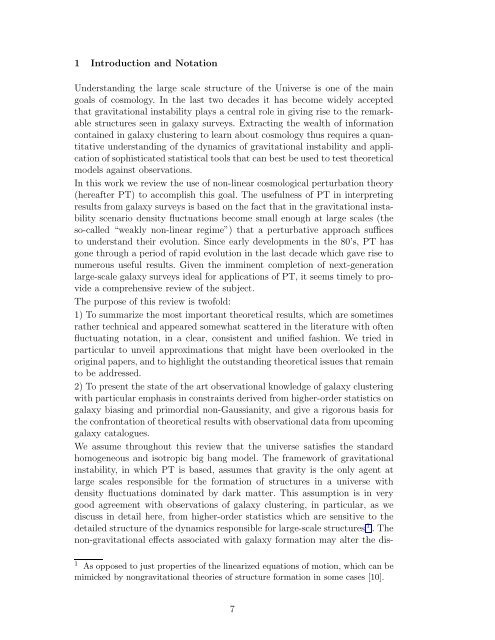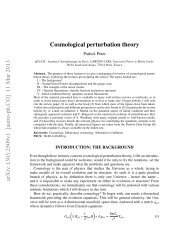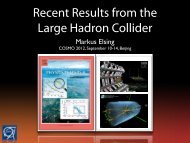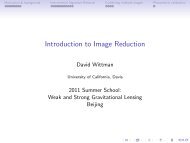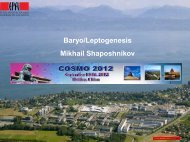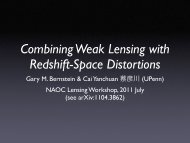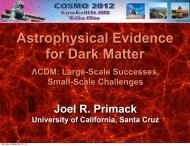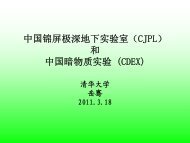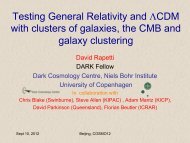Large-Scale Structure of the Universe and Cosmological ...
Large-Scale Structure of the Universe and Cosmological ...
Large-Scale Structure of the Universe and Cosmological ...
Create successful ePaper yourself
Turn your PDF publications into a flip-book with our unique Google optimized e-Paper software.
1 Introduction <strong>and</strong> Notation<br />
Underst<strong>and</strong>ing <strong>the</strong> large scale structure <strong>of</strong> <strong>the</strong> <strong>Universe</strong> is one <strong>of</strong> <strong>the</strong> main<br />
goals <strong>of</strong> cosmology. In <strong>the</strong> last two decades it has become widely accepted<br />
that gravitational instability plays a central role in giving rise to <strong>the</strong> remarkable<br />
structures seen in galaxy surveys. Extracting <strong>the</strong> wealth <strong>of</strong> information<br />
contained in galaxy clustering to learn about cosmology thus requires a quantitative<br />
underst<strong>and</strong>ing <strong>of</strong> <strong>the</strong> dynamics <strong>of</strong> gravitational instability <strong>and</strong> application<br />
<strong>of</strong> sophisticated statistical tools that can best be used to test <strong>the</strong>oretical<br />
models against observations.<br />
In this work we review <strong>the</strong> use <strong>of</strong> non-linear cosmological perturbation <strong>the</strong>ory<br />
(hereafter PT) to accomplish this goal. The usefulness <strong>of</strong> PT in interpreting<br />
results from galaxy surveys is based on <strong>the</strong> fact that in <strong>the</strong> gravitational instability<br />
scenario density fluctuations become small enough at large scales (<strong>the</strong><br />
so-called “weakly non-linear regime”) that a perturbative approach suffices<br />
to underst<strong>and</strong> <strong>the</strong>ir evolution. Since early developments in <strong>the</strong> 80’s, PT has<br />
gone through a period <strong>of</strong> rapid evolution in <strong>the</strong> last decade which gave rise to<br />
numerous useful results. Given <strong>the</strong> imminent completion <strong>of</strong> next-generation<br />
large-scale galaxy surveys ideal for applications <strong>of</strong> PT, it seems timely to provide<br />
a comprehensive review <strong>of</strong> <strong>the</strong> subject.<br />
The purpose <strong>of</strong> this review is tw<strong>of</strong>old:<br />
1) To summarize <strong>the</strong> most important <strong>the</strong>oretical results, which are sometimes<br />
ra<strong>the</strong>r technical <strong>and</strong> appeared somewhat scattered in <strong>the</strong> literature with <strong>of</strong>ten<br />
fluctuating notation, in a clear, consistent <strong>and</strong> unified fashion. We tried in<br />
particular to unveil approximations that might have been overlooked in <strong>the</strong><br />
original papers, <strong>and</strong> to highlight <strong>the</strong> outst<strong>and</strong>ing <strong>the</strong>oretical issues that remain<br />
to be addressed.<br />
2) To present <strong>the</strong> state <strong>of</strong> <strong>the</strong> art observational knowledge <strong>of</strong> galaxy clustering<br />
with particular emphasis in constraints derived from higher-order statistics on<br />
galaxy biasing <strong>and</strong> primordial non-Gaussianity, <strong>and</strong> give a rigorous basis for<br />
<strong>the</strong> confrontation <strong>of</strong> <strong>the</strong>oretical results with observational data from upcoming<br />
galaxy catalogues.<br />
We assume throughout this review that <strong>the</strong> universe satisfies <strong>the</strong> st<strong>and</strong>ard<br />
homogeneous <strong>and</strong> isotropic big bang model. The framework <strong>of</strong> gravitational<br />
instability, in which PT is based, assumes that gravity is <strong>the</strong> only agent at<br />
large scales responsible for <strong>the</strong> formation <strong>of</strong> structures in a universe with<br />
density fluctuations dominated by dark matter. This assumption is in very<br />
good agreement with observations <strong>of</strong> galaxy clustering, in particular, as we<br />
discuss in detail here, from higher-order statistics which are sensitive to <strong>the</strong><br />
detailed structure <strong>of</strong> <strong>the</strong> dynamics responsible for large-scale structures 1 . The<br />
non-gravitational effects associated with galaxy formation may alter <strong>the</strong> dis-<br />
1 As opposed to just properties <strong>of</strong> <strong>the</strong> linearized equations <strong>of</strong> motion, which can be<br />
mimicked by nongravitational <strong>the</strong>ories <strong>of</strong> structure formation in some cases [10].<br />
7


